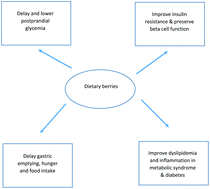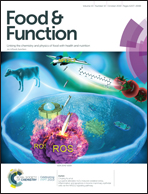Dietary berries, insulin resistance and type 2 diabetes: an overview of human feeding trials
Abstract
Dietary berries are a rich source of several nutrients and phytochemicals and in recent years, accumulating evidence suggests they can reduce risks of several chronic diseases, including type 2 diabetes (T2D). The objective of this review is to summarize and discuss the role of dietary berries (taken as fresh, frozen, or other processed forms) on insulin resistance and biomarkers of T2D in human feeding studies. Reported feeding trials involve different berries taken in different forms, and consequently differences in nutritional or polyphenol composition must be considered in their interpretation. Commonly consumed berries, especially cranberries, blueberries, raspberries and strawberries, ameliorate postprandial hyperglycemia and hyperinsulinemia in overweight or obese adults with insulin resistance, and in adults with the metabolic syndrome (MetS). In non-acute long-term studies, these berries either alone, or in combination with other functional foods or dietary interventions, can improve glycemic and lipid profiles, blood pressure and surrogate markers of atherosclerosis. Studies specifically in people with T2D are few, and more knowledge is needed. Nevertheless, existing evidence, although sparse, suggests that berries have an emerging role in dietary strategies for the prevention of diabetes and its complications in adults. Despite the beneficial effects of berries on diabetes prevention and management, they must be consumed as part of a healthy and balanced diet.

- This article is part of the themed collection: Berry Health Benefits Symposium


 Please wait while we load your content...
Please wait while we load your content...